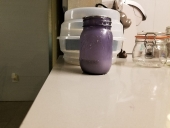I want to take out the grass for several reasons. First, it just gets so tall! Easily 4 feet. It's hard for us to keep up with either a weed-eater or a lawn mower. It's excellent forage for livestock- but overwhelms the fruit trees as well as us. The first year we weren't so busy with everything else and we had more time to keep it mowed down. But, as we continue to plant more trees as well as grow our farm in general- it's just too much. And then there is the taking away nutrients from the trees themselves. The grass also provides great hiding spots for voles, mice, etc.
I did some more reading on the comfrey and decided it's probably not the best thing for us to use at this point. It sounds like it would be great if I planted it 3 to 4 feet away from the trees. But right now my main focus is to remove the grass from around the base of the trees. Last year I removed the grass from around 20 trees and planted a clover- I don't remember which one. I didn't use rocks or anything else, just the clover. But the grass grew back and I never saw any of the clover. I don't want to start adding transplants that will just get over run by the grass. We're talking orchard grass, canary grass and a few other kinds. Not the basic lawn grass that most people have in their backyards. Of course, our whole property is like this or we would have picked a different spot for the orchard.
I'm starting to think I should try smothering it out with cardboard, leaves etc. We have dairy cows and I could work on composting their manure and old hay, then pile that on top of the cardboard.
Maybe I'll try a combination of the ideas all of you have shared on just a few of the trees and then wait it out to see which one works the best. It doesn't sound like there is a "quick fix" lol.


